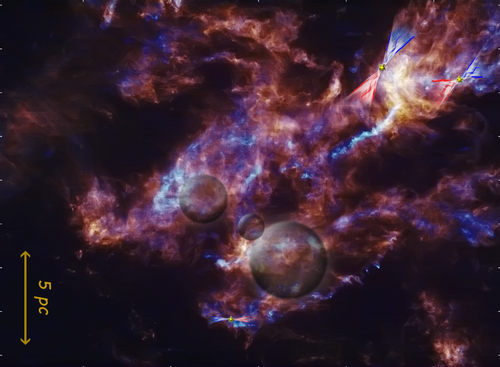Formation of new stars disturbs their natal clouds, giving rise to dynamical structures, namely, outflows and bubbles.
The researchers at National Astronomical Observatories of Chinese Academy of Sciences (NAOC) lead by Huixian Li and her PhD adviser Di Li published a comprehensive sample of dynamical structures based on the largest continuous CO maps to-date of Taurus molecular cloud complex. In about 100 d2 area with over 310 million voxels, they examined regions around every protostar identified by the Spitzer Space Telescope Taurus Legacy Survey and managed to detect 55 outflows and 37 bubbles. All the bubbles and 31 of the outflows are new detection. Although the total energy of these dynamical structures is much smaller than the turbulent energy of Taurus molecular clouds, the energy injection rate was found to be similar to the turbulence dissipation rate, i.e., the star formation feedback is sufficient in sustaining the turbulence!
This work is published in the Astrophysical Journal Supplement Series(Li, et al. ApJS, 2015, 219, 20). The paper was received positively by the referee-- "the paper is extremely useful and should be a key reference work in all future theoretical and observational studies of star formation", who also helped improved the article in several crucial aspects.
How low mass young stars can drive so much energy remains a mystery and will be examined in future works.

The background is FCRAO 12CO(1-0) and 13CO(1-0) integrated intensity. The blue and red sectors representoutflows and the transparent spheres represent bubbles. (Credit: NAOC)

Address: 20A Datun Road, Chaoyang District, Beijing, China code: 100012
Tel: 010-64888708 E-mail: naoc@nao.cas.cn

